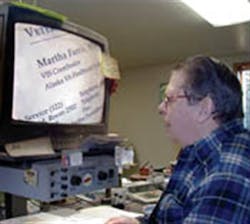Living and operating a tire dealership in Alaska comes with its own little unique problems and challenges. You deal with them, live with them or work around them. You cannot ignore them.
In 1996, I faced a new and unique challenge. I started losing my sight to an incurable eye disease. By 1998, I was legally blind, which affected my ability to manage my business. I could not work around it or ignore it. I was CEO, COO, CFO, advertising manager, part-time janitor and tire technician. I needed me.
After an ophthalmologist gave me the bad news, I was ushered to the cashier; the doctor said good-luck and waved goodbye as he walked back to his office. I was on my own. I left knowing nothing about the eye disease. I needed to know how it might affect me and how I might deal with it. After some investigation, I realized that I would need help and that technology would be playing a big role in my life.
Up until then, my "technology" was limited to a calculator. I had resisted computerization, although I had recently purchased one to aid in communicating with various suppliers.
I also purchased a "reading machine," which was a high-power magnifier that would project a magnified image of items placed under it onto a 20-inch monitor above it. This magnified reading material sufficiently for me to see it and also allowed me to write.
The Department of Veterans Affairs has excellent training programs for blind and visually impaired veterans. They sent me to a blind rehabilitation center, where I received seven weeks of intense training. This turned out to be the best thing that I could have done. I gained back a lot of the self-confidence that I had lost.
The training stressed the use of my other senses. I found that these senses do not improve, but I could learn to use them more efficiently. Our tactile senses (touch), hearing and even smell are used a lot more by the blind and visually impaired.
My sense of touch became very important and useful to me at my tire dealership. I could not recognize faces, read standard print or even feel the tire sizes molded into the tire. I could not read the numbers on a tread depth gauge or see the wear patterns on a tire, but I could use my sense of touch.
I fine-tuned this sense to the point that I could determine tread depth by feel to within 1/32nd of an inch. I could also feel the wear pattern and determine the necessity of an alignment. I could usually determine if there was a toe-in/out problem, camber-caster, and even ball joints- and shock-caused wear.
Most of my regular customers knew of my vision problem and accepted the results of my "tire inspections." Others never knew that a "blind guy" had "seen" and evaluated their tires.
[PAGEBREAK]
Technology, training and visual aids were a big help, but it was the understanding, help and support of my family, friends, staff and customers that allowed me to adapt and adjust to my lost vision.
I believe that we all have abilities and capabilities to learn, adjust and adapt to almost anything that we set our minds to.
About the author
Mike Harmer, 66, owned and managed his own tire stores from 1978 until 2003. He started in retail tire sales with the BFGoodrich Tire Group in 1967. He also was employed by the Firestone Tire & Rubber Co. In 2004 he wrote a book about the physical and emotional problems he has faced since his sight began deteriorating. "How to go blind...and not lose your mind!" has been published and is now available from Publication Consultants for $14.95. Call (907) 349-2424
or visit Web site www.publicationconsultants.com. Below is the book's introduction.
Harmer also heads up a low vision support group and is on the board of directors of an Independent Living Center that serves Alaska's Kenai Peninsula.Introduction to: "How to go blind... and not lose your mind!"
By R. "Mike" Harmer
Losing your sight and learning to live with reduced or even no vision is a major event, and one that we do not plan on happening to us. Unfortunately, according to the National Eye Institute, approximately 130,000 Americans will be afflicted with blindness or a visual impairment this year. The vast majority of these will be from one of four major eye diseases, and others from injury. It happened to me.
On a trip to my local library, I could find no book that would help prepare me to deal with my vision loss. I thought that there should be.
This book is the one that I had been looking for. If you or a loved one is in the process of sight loss, this book could be of help. It should make living with "low vision" a little easier.
I am not a low vision specialist, or a doctor. I am not an expert at anything. I am merely an ordinary person, who has learned to live with "low vision."
I have learned to live with my vision impairment, and I would like to share what I have learned in the hope that it will make life a little easier for someone else who may be losing his or her sight.
Losing your sight is not an easy thing to do, but it does not have to be hard. It can happen rapidly or slowly, and it can happen to anyone. How you deal with it will not only affect you, but also those around you. It can be an interesting side trip on this road we call life, and it can be scary without a map. If you are reading this book, then you are on the right road.



